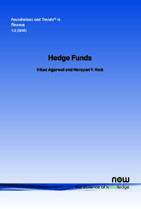Hedge Funds
By Vikas Agarwal, Georgia State University, Robinson College of Business, USA, vagarwal@gsu.edu | Narayan Y. Naik, London Business School, UK, nnaik@london.edu
Abstract
Hedge Funds summarizes the academic research on hedge funds and commodity trading advisors. The hedge fund industry has grown tremendously over the recent years. According to some industry estimates, hedge funds have increased from USD 39 million in 1990 to about USD 972 million in 2004 and the total number of hedge funds has gone up from 610 to 7,436 over the same period. At the same time, hedge fund strategies have changed significantly. In 1990 the macro strategy dominated the industry while in 2004 the equity hedge strategy had the largest share of the market. There has also been a shift in the type of investor in hedge funds. In the early 1990s the typical investor was a high net-worth individual investor, today the typical investor is an institutional investor. Thus, the hedge fund market has not only grown tremendously, but the nature of the market has changed.
Despite the enormous growth of this industry, there is limited information available on hedge funds. As a result, there is a need for rigorous research from both the investors' and regulators' point of view. Investors need research to better understand their investment and their risk exposure. This research also helps investors recognize the extent of diversification benefits hedge funds offer in combination with investments in traditional asset classes, such as stocks and bonds. Regulators can use this research to identify situations where regulation may be needed to protect investors' interests and to understand the impact hedge funds trading strategies have on the stability of the financial markets.
The first part of Hedge Funds summarizes hedge fund performance, including comparisons of risk-return characteristics of hedge funds with those of mutual funds, factors driving hedge fund returns, and persistence in hedge fund performance. The second part reviews research regarding the unique contractual features and characteristics of hedge funds and their influence on the risk-return tradeoffs. The third part reviews the role of hedge funds in a portfolio including the extent of diversification benefits and limitations of standard mean-variance framework for asset allocation. Finally, the authors summarize the research on the biases in hedge fund databases.
Hedge Funds
Hedge Funds summarizes the academic research on hedge funds and commodity trading advisors. The hedge fund industry has grown tremendously over the recent years. According to some industry estimates, hedge funds have increased from $39 million in 1990 to about $972 million in 2004 and the total number of hedge funds has gone up from 610 to 7,436 over the same period. At the same time, hedge fund strategies have changed significantly. In 1990 the macro strategy dominated the industry while in 2004 the equity hedge strategy had the largest share of the market. There has also been a shift in the type of investor in hedge funds. In the early 1990's the typical investor was a high net-worth individual investor, today the typical investor is an institutional investor. Thus, the hedge fund market has not only grown tremendously, but the nature of the market has changed. Despite the enormous growth of this industry, there is limited information available on hedge funds. As a result, there is a need for rigorous research from both the investors' and regulators' point of view. Investors need research to better understand their investment and their risk exposure. This research also helps investors recognize the extent of diversification benefits hedge funds offer in combination with investments in traditional asset classes, such as stocks and bonds. Regulators can use this research to identify situations where regulation may be needed to protect investors' interests and to understand the impact hedge funds trading strategies have on the stability of the financial markets. The first part of Hedge Funds summarizes hedge fund performance, including comparisons of risk-return characteristics of hedge funds with those of mutual funds, factors driving hedge fund returns, and persistence in hedge fund performance. The second part reviews research regarding the unique contractual features and characteristics of hedge funds and their influence on the risk-return tradeoffs. The third part reviews the role of hedge funds in a portfolio including the extent of diversification benefits and limitations of standard mean-variance framework for asset allocation. Finally, the authors summarize the research on the biases in hedge fund databases.

Companion
The Economics and Finance of Hedge Funds: A Review of the Academic Literature
, Foundations and Trends® in Finance, Volume 10, Issue 1 10.1561/0500000047
This is an updated version of this survey.